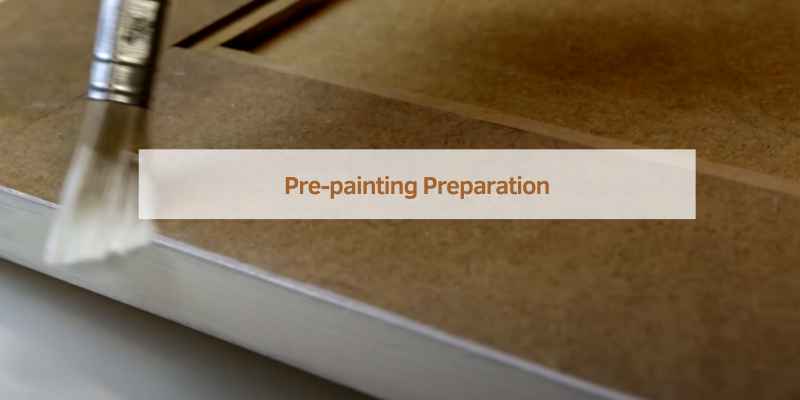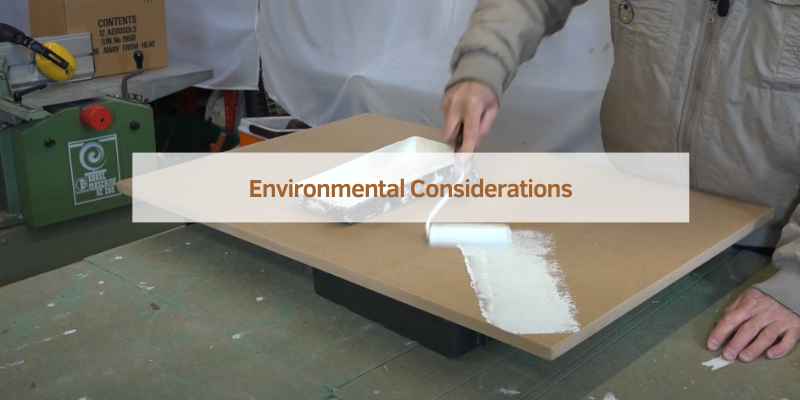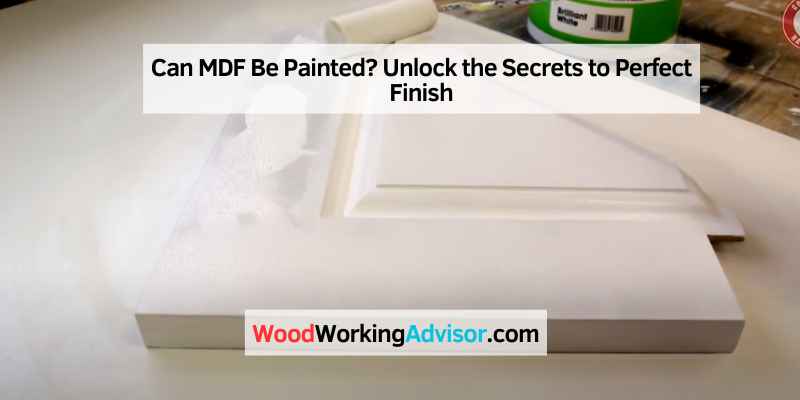Yes, MDF can be painted. Proper preparation and priming ensure a smooth and durable finish.
Medium-Density Fiberboard (MDF) is a popular material for various woodworking projects due to its affordability and versatility. MDF offers a smooth surface that can be easily painted, making it ideal for DIY projects, furniture, and cabinetry. Achieving a professional-looking finish on MDF requires some preparation.
Sand the surface to remove any imperfections and apply a quality primer to seal the porous material. Use multiple thin coats of paint for an even, durable finish. With the right steps, painting MDF can result in an attractive and lasting outcome.
Pre-painting Preparation
Painting Medium Density Fiberboard (MDF) requires careful preparation. Proper pre-painting steps ensure a smooth, lasting finish. Start with cleaning and sanding the MDF surface. This makes it ready for priming and painting. Below are key steps for pre-painting preparation.
Surface Cleaning
Clean the MDF surface before painting. Use a dry cloth to remove dust. For greasy stains, use a damp cloth with mild soap. Make sure the surface is completely dry before moving to the next step.
Sanding Techniques For Mdf
Sanding is crucial for a smooth finish. Follow these steps for effective sanding:
- Use 120-grit sandpaper for the first pass.
- Sand in small, circular motions.
- Wipe off the dust with a dry cloth.
- Switch to 220-grit sandpaper for a finer finish.
- Sand lightly to avoid damaging the MDF.
- Clean the surface again to remove all dust.
Proper sanding ensures the paint adheres well. This step is essential for a professional-looking finish.

Priming Mdf For Painting
Painting MDF (Medium Density Fiberboard) can transform it into a stunning piece. But before painting, priming MDF is crucial. Priming helps the paint adhere better and ensures a smooth finish. Let’s explore the best ways to prime MDF.
Choosing The Right Primer
Selecting the correct primer is essential. A high-quality primer ensures better paint adhesion and a smoother finish. Here are some types of primers you can use:
| Primer Type | Benefits |
|---|---|
| Oil-Based Primer | Seals MDF well and prevents swelling |
| Shellac-Based Primer | Dries quickly and provides excellent coverage |
| Water-Based Primer | Low odor and easy cleanup |
Application Tips For Smooth Coverage
Applying primer correctly ensures a smooth surface for painting. Follow these steps for the best results:
- Sand the MDF: Use fine-grit sandpaper to smooth the surface. Sanding removes rough edges and helps the primer stick.
- Clean the Surface: Wipe the MDF with a damp cloth to remove dust. A clean surface ensures better primer adhesion.
- Apply the Primer: Use a brush or roller to apply an even coat. Apply multiple thin coats rather than one thick coat.
- Let it Dry: Allow the primer to dry completely before sanding again. This ensures a smooth surface for the final paint.
- Sand Again: Lightly sand the primed surface with fine-grit sandpaper. This step smooths out any imperfections.
Following these tips ensures your MDF is well-prepared for painting. Proper priming is the key to a beautiful, lasting finish.
Selecting Paint For Mdf
Painting MDF (Medium Density Fiberboard) can transform your projects, giving them a polished and professional look. Selecting the right paint is crucial to achieving a smooth and durable finish. Let’s explore the options and factors to consider when choosing paint for MDF.
Oil-based Vs. Water-based Options
Choosing between oil-based and water-based paint depends on your project’s needs. Both have pros and cons.
| Paint Type | Pros | Cons |
|---|---|---|
| Oil-Based Paint |
|
|
| Water-Based Paint |
|
|
The Impact Of Paint Sheen
Paint sheen affects the final look and durability of your MDF project. Choosing the right sheen is important.
- Flat and Matte: Hides imperfections but less durable.
- Eggshell and Satin: Slightly shiny, more durable, and easy to clean.
- Semi-Gloss and Gloss: Very shiny, highly durable, ideal for high-traffic areas.
Flat and matte finishes are good for low-traffic areas. Eggshell and satin are balanced choices. Semi-gloss and gloss are best for durability and easy cleaning.
Painting Techniques
Painting MDF (Medium Density Fiberboard) can transform its appearance and durability. Using the right techniques ensures a smooth and long-lasting finish. Below, we explore different methods and tips to achieve the best results.
Brush, Roll, Or Spray?
Choosing the right tool is crucial for painting MDF. Each tool has its own advantages and limitations.
| Tool | Advantages | Disadvantages |
|---|---|---|
| Brush | Great for small areas Offers control |
Can leave brush marks Slower application |
| Roller | Ideal for large surfaces Even finish |
Not suitable for corners Can be messy |
| Spray | Provides smooth finish Fast application |
Requires prep work Needs ventilation |
Avoiding Common Painting Mistakes
Common mistakes can affect the quality of your paint job. Follow these tips to avoid them:
- Priming: Always prime MDF before painting. This seals the surface and prevents paint absorption.
- Sanding: Sand between coats for a smooth finish. Use fine-grit sandpaper.
- Thin Coats: Apply thin coats of paint. This prevents drips and ensures even coverage.
- Drying Time: Allow each coat to dry completely. Rushing can lead to a sticky finish.
- Ventilation: Paint in a well-ventilated area. This helps the paint dry evenly and reduces fumes.
Layering And Finishing
Painting MDF is a rewarding task. The key to success lies in the layering and finishing process. Proper layering and finishing ensure a smooth, durable surface. This section will guide you through the steps to achieve a professional look.
The Art Of Layering Paint
Layering paint on MDF requires patience and precision. Start by applying a primer. A primer helps the paint adhere better. It also seals the MDF surface.
Once the primer is dry, apply the first coat of paint. Use a brush or roller for even coverage. Let each layer dry completely before adding the next. This ensures the paint bonds well.
Typically, two to three coats are sufficient. For a more vibrant finish, add an extra coat. Sand lightly between layers with fine-grit sandpaper. This removes any imperfections.
Achieving A Professional Finish
To achieve a professional finish, focus on the final touches. After the last coat of paint dries, inspect the surface. Look for any uneven areas or brush marks.
If needed, sand these areas lightly. Then, clean the surface with a damp cloth to remove dust. Finally, apply a clear topcoat for protection. This adds durability and a polished look.
Using a high-quality brush or roller is crucial. It helps in achieving a smooth, streak-free finish. Also, ensure good ventilation while painting. This aids in faster drying and better results.
| Step | Description |
|---|---|
| 1 | Apply primer to seal the MDF surface. |
| 2 | Apply the first coat of paint evenly. |
| 3 | Let each layer dry completely. |
| 4 | Sand lightly between coats. |
| 5 | Inspect and sand any imperfections. |
| 6 | Apply a clear topcoat for protection. |
- Use a primer for better paint adhesion.
- Apply multiple coats for even coverage.
- Sand between layers for a smooth finish.
- Inspect and touch up imperfections.
- Use a topcoat for added durability.
Curing And Drying Time
Understanding the curing and drying time of MDF (Medium-Density Fiberboard) is essential for achieving a flawless paint finish. MDF needs proper handling after painting to ensure the paint adheres well and lasts long. This section will guide you through the ideal conditions for drying and how long to wait before using your painted MDF.
Ideal Conditions For Drying
The ideal conditions for drying painted MDF include the right temperature, humidity, and ventilation. You want to keep the temperature between 60°F and 75°F (15°C to 24°C). This range is perfect for paint to dry evenly.
- Keep the humidity level between 40% and 50%.
- Ensure proper ventilation by opening windows or using fans.
- Avoid direct sunlight as it can cause the paint to dry too quickly.
These conditions will help the paint cure properly on your MDF, giving it a smooth and durable finish.
How Long To Wait Before Use
Once you’ve painted your MDF, waiting for the right time before using it is crucial. Here is a simple table to guide you:
| Step | Time to Wait |
|---|---|
| Initial Drying | 1-2 hours |
| Touch Dry | 6-8 hours |
| Handle Dry | 24 hours |
| Fully Cured | 7 days |
Initial drying takes about 1-2 hours. This is when the surface feels dry to the touch. After 6-8 hours, the paint is touch dry, meaning you can lightly touch it without smudging.
Wait 24 hours for the paint to be handle dry. At this stage, you can handle the MDF gently. For the paint to be fully cured and durable, wait a full 7 days. This ensures the paint has hardened completely and can withstand daily use.
Maintenance Of Painted Mdf
Maintaining painted MDF is essential for its durability and appearance. Regular upkeep ensures the surface stays smooth and vibrant. Proper care can extend the life of the painted finish.
Cleaning Painted Surfaces
Cleaning painted MDF surfaces is simple. Use a soft cloth or sponge. Avoid abrasive materials that can scratch the paint.
Follow these steps to clean painted MDF:
- Mix mild soap with warm water.
- Dip the cloth or sponge in the soapy water.
- Gently wipe the surface, removing dirt and stains.
- Rinse with clean water and dry with a soft towel.
Avoid soaking the MDF as excessive moisture can damage it. Always ensure the surface is dry after cleaning.
Touch-up Tips For Longevity
Touching up painted MDF helps maintain its look. Small chips or scratches can be easily fixed.
Here are some tips for touching up painted MDF:
- Sand the damaged area lightly to smooth it.
- Clean the area with a damp cloth to remove dust.
- Apply matching paint with a small brush.
- Allow the paint to dry completely.
- Apply a second coat if needed for full coverage.
Regular inspections can help identify areas needing touch-ups early. Keeping a small amount of matching paint on hand is useful for quick fixes.
| Maintenance Task | Frequency | Materials Needed |
|---|---|---|
| Cleaning | Monthly | Soft cloth, mild soap, water |
| Touch-Ups | As needed | Sandpaper, matching paint, small brush |
Proper maintenance of painted MDF ensures it remains beautiful and functional for years. Regular cleaning and timely touch-ups prevent larger issues and maintain its appeal.
Creative Ideas For Painted Mdf
Medium-density fiberboard (MDF) is a versatile material. It can be painted in many creative ways. Painting MDF can transform any space. Here are some exciting ideas to get you started.
Color And Pattern Inspiration
Choosing the right color can make a big difference. Bold colors like red or blue can make a statement. Soft pastels can create a calming effect. You can also mix and match colors for a unique look.
- Bold Colors: Red, Blue, Yellow
- Soft Pastels: Pink, Light Blue, Mint Green
- Neutral Shades: White, Gray, Beige
Patterns add an extra touch. Stripes, polka dots, or geometric shapes can make your MDF stand out. You can use stencils for precise designs.
| Pattern | Effect |
|---|---|
| Stripes | Modern, Sleek |
| Polka Dots | Fun, Playful |
| Geometric | Edgy, Contemporary |
Diy Projects Using Painted Mdf
Painted MDF can be used in many DIY projects. It is perfect for home decor and furniture. Here are some ideas to inspire you.
- Wall Art: Create custom wall art with painted MDF panels.
- Shelves: Paint MDF shelves to match your room’s decor.
- Furniture: Use painted MDF to make unique furniture pieces.
Small projects can also have a big impact. Try painting coasters, picture frames, or even drawer knobs.
- Painted Coasters
- Custom Picture Frames
- Colorful Drawer Knobs
Painting MDF opens up endless possibilities. You can personalize your space with ease. Get creative and have fun with it!
Environmental Considerations
Painting MDF can be an environmentally friendly choice. It’s important to consider the impact of the paint and disposal process. The right decisions can help reduce environmental harm.
Eco-friendly Paint Options
Using eco-friendly paint is a great way to minimize environmental impact. Choose paints labeled as low-VOC (Volatile Organic Compounds). These paints release fewer harmful chemicals into the air.
Here are some eco-friendly paint options:
- Water-based paints: These paints have lower VOC levels and dry quickly.
- Naturally derived paints: Made from natural ingredients like clay, milk, and plant dyes.
- Recycled paint: Made from leftover paints that are reprocessed and resold.
These options are better for both your health and the environment.
Disposal Of Mdf And Paint
Proper disposal of MDF and paint is crucial. MDF (Medium Density Fiberboard) can release formaldehyde if not handled correctly. It should not be burned or disposed of in regular trash.
Follow these steps for safe disposal:
- Contact local waste management: They can provide guidelines on MDF disposal.
- Recycle if possible: Some facilities accept MDF for recycling.
- Dispose of paint safely: Do not pour paint down the drain. Take leftover paint to a hazardous waste facility.
Proper disposal helps reduce environmental damage and keeps harmful substances out of the ecosystem.

Frequently Asked Questions
What Kind Of Paint To Use On Mdf?
Use acrylic or latex paint on MDF. Prime the surface first for better adhesion and finish. Ensure proper ventilation.
Does Mdf Warp When Painted?
MDF can warp if not sealed properly before painting. Use a primer to prevent moisture absorption.
How To Seal Mdf Before Painting?
Seal MDF by applying a thin coat of primer. Sand the surface lightly after it dries. Apply a second primer coat if needed. Use a high-quality paintbrush or roller for best results. Ensure the surface is smooth before painting.
Can I Spray Paint Mdf?
Yes, you can spray paint MDF. Ensure the surface is clean and primed. Use multiple thin coats for best results.
Conclusion
Painting MDF can transform its appearance and enhance durability. Proper preparation and the right paint ensure great results. Remember to seal and prime the surface to avoid moisture damage. With these steps, your MDF projects will look professional and last longer.
Enjoy your beautifully painted MDF creations!


